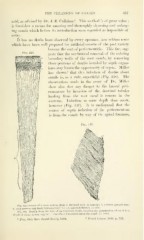Page 459 - My FlipBook
P. 459
THE CLEANSING OF CANALS. 457
acid, as advised bv Dr. J. E. Callahan.^ This method is of great value ;
it furnishes a means for entering and thoroughly cleansing and enlarg-
ing canals which before its introduction were regarded as impossible of
entry.
It has no doubt been observed by every operator, how seldom roots
which have been well prepared for artificial crowns of the post variety
become the seat of pericementitis. This fact sug-
Fig. 448.
o-ests that the mechanical removal of the existing
boundary walls of the root canals, by removing
those portions of dentin invaded by septic organ-
isms may lessen the opportunity of sepsis. Miller
has shown- that this infection of dentin about
canals is, as a rule, superficial (Fig. 448). The
observations made in the essay of Dr. Miller
show also that any danger to the lateral peri-
cementum by invasion of the
II dentinal tubules
leading from the root canal is remote in the
extreme. Infection to some depth does occur,
however (Fig. 449). It is undisputed that the
source of septic infection of the pericementum
is from the canals by way of the apical foramen.
Fig. 449.
i:ii if!
V\
Fig. 448.—Sector of a cross section from a diseased root: a, cement; h, stratum granulosum :
.c, very narrow and finely branched tubules ; d, infected district. (X 150.)
Fi". 449.—Dentin from the root of an abscessed tooth, showing the penetration of cocci to a
depth "of about ^^ mm. (jjs in.). The side a-b bordered upon the canal. (X 1000.)
1 Proc. Ohio State Denial Society, 1894. ^ Dental Cosmos, 1890, p. 353.


